A Lesson Plan for Developing Language Skills and Knowledge
VerifiedAdded on 2020/10/22
|8
|2277
|369
Report
AI Summary
This report presents a detailed lesson plan designed to enhance language skills and knowledge in students aged 13-20. The plan, spanning 5-12 hours, focuses on reading, learning, and assessing information through various activities. These include developing skills in organizing information from books and journals, improving learning through fluent English paragraphs, expanding knowledge from diverse books, and gaining insights into different cultures. The lesson plan incorporates activities, resources like books and magazines, and assessment methods to evaluate student progress. The rationale emphasizes the importance of language skills for understanding different languages and cultures, with a focus on improving reading comprehension, vocabulary, and cultural awareness. The plan also includes various components and a unit design that facilitates effective teaching and learning, with a conclusion summarizing the key elements and benefits of the lesson plan. The plan includes references from various authors to support the points taken in the lesson plan.
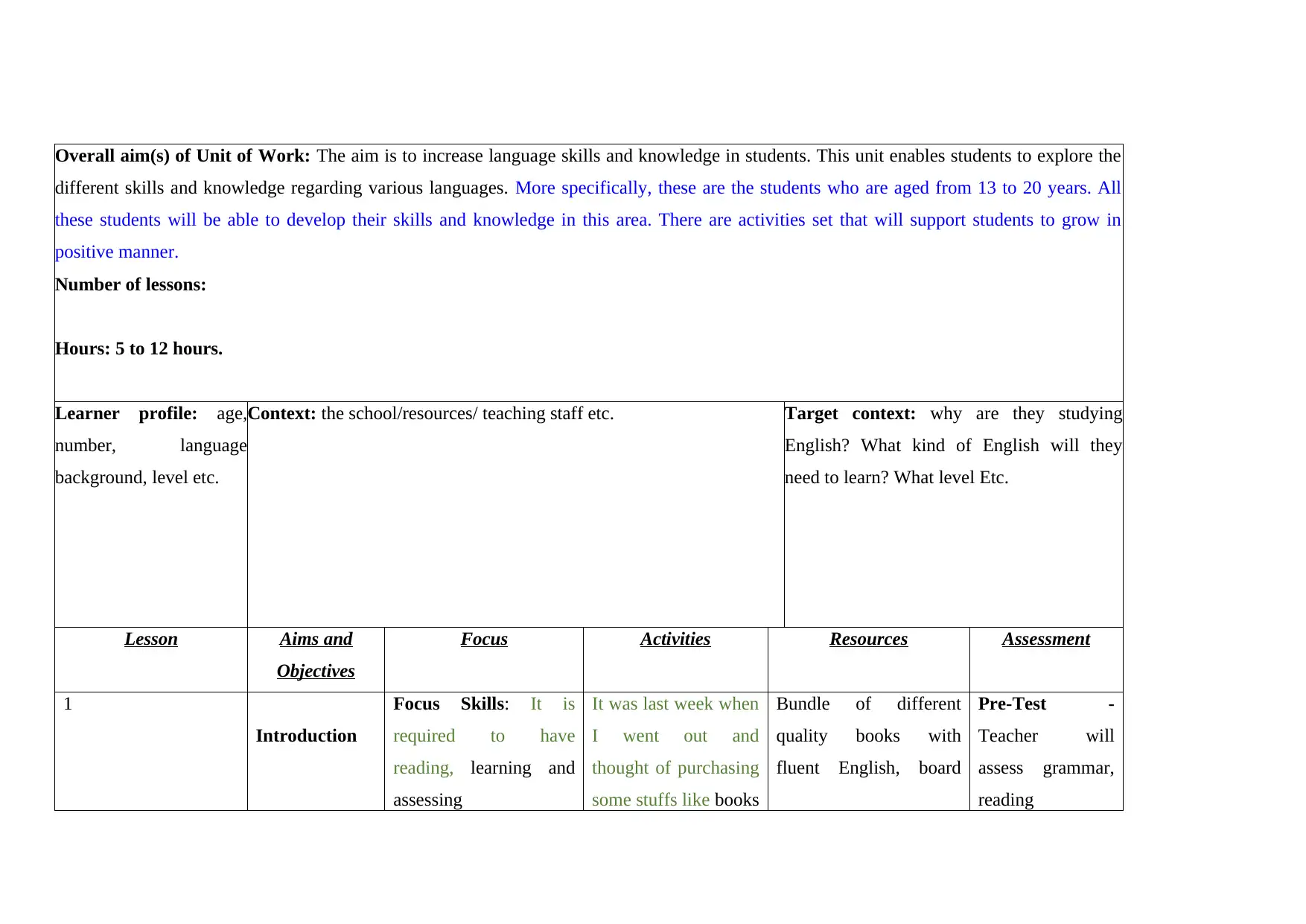
Overall aim(s) of Unit of Work: The aim is to increase language skills and knowledge in students. This unit enables students to explore the
different skills and knowledge regarding various languages. More specifically, these are the students who are aged from 13 to 20 years. All
these students will be able to develop their skills and knowledge in this area. There are activities set that will support students to grow in
positive manner.
Number of lessons:
Hours: 5 to 12 hours.
Learner profile: age,
number, language
background, level etc.
Context: the school/resources/ teaching staff etc. Target context: why are they studying
English? What kind of English will they
need to learn? What level Etc.
Lesson Aims and
Objectives
Focus Activities Resources Assessment
1
Introduction
Focus Skills: It is
required to have
reading, learning and
assessing
It was last week when
I went out and
thought of purchasing
some stuffs like books
Bundle of different
quality books with
fluent English, board
Pre-Test -
Teacher will
assess grammar,
reading
different skills and knowledge regarding various languages. More specifically, these are the students who are aged from 13 to 20 years. All
these students will be able to develop their skills and knowledge in this area. There are activities set that will support students to grow in
positive manner.
Number of lessons:
Hours: 5 to 12 hours.
Learner profile: age,
number, language
background, level etc.
Context: the school/resources/ teaching staff etc. Target context: why are they studying
English? What kind of English will they
need to learn? What level Etc.
Lesson Aims and
Objectives
Focus Activities Resources Assessment
1
Introduction
Focus Skills: It is
required to have
reading, learning and
assessing
It was last week when
I went out and
thought of purchasing
some stuffs like books
Bundle of different
quality books with
fluent English, board
Pre-Test -
Teacher will
assess grammar,
reading
Paraphrase This Document
Need a fresh take? Get an instant paraphrase of this document with our AI Paraphraser
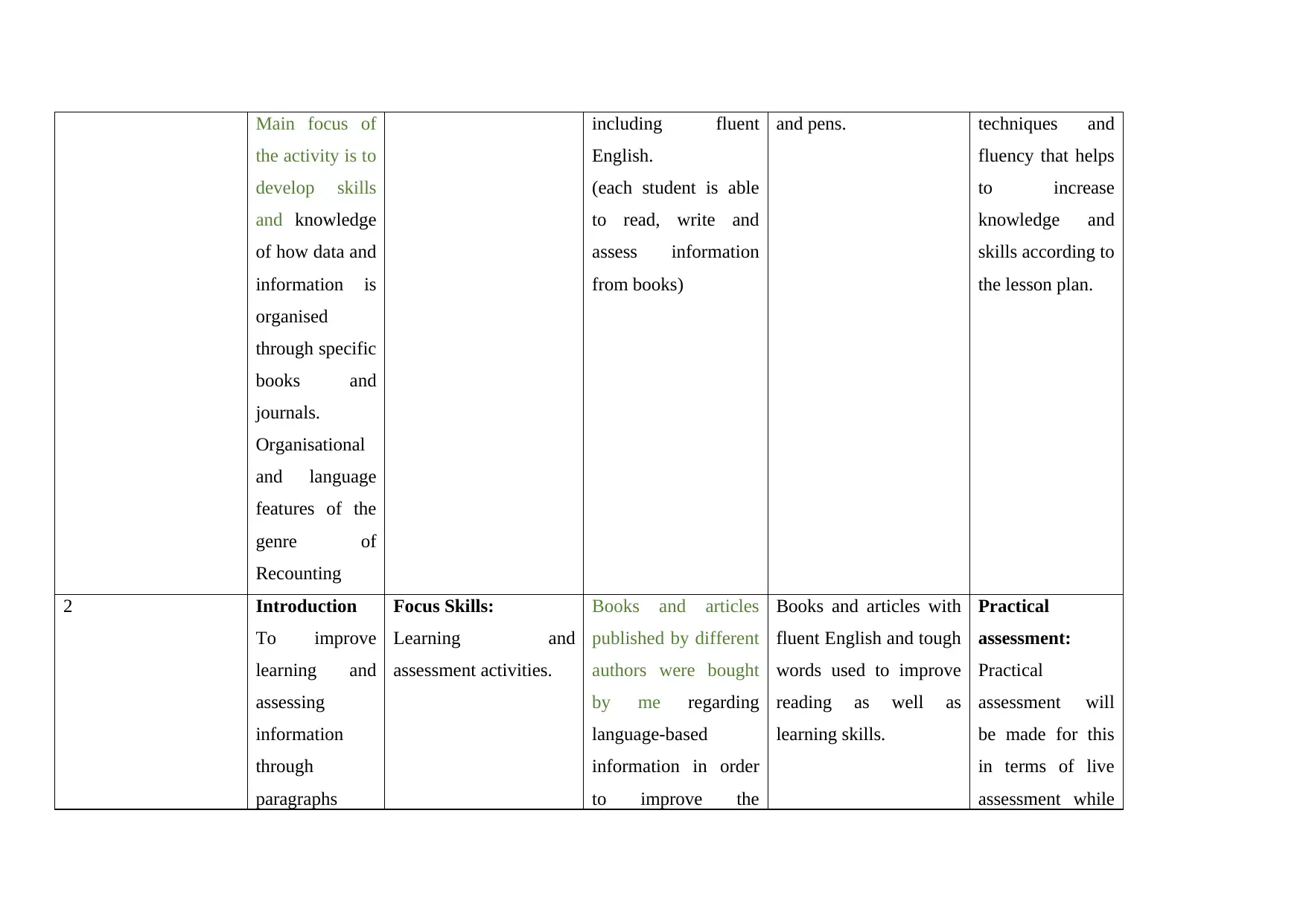
Main focus of
the activity is to
develop skills
and knowledge
of how data and
information is
organised
through specific
books and
journals.
Organisational
and language
features of the
genre of
Recounting
including fluent
English.
(each student is able
to read, write and
assess information
from books)
and pens. techniques and
fluency that helps
to increase
knowledge and
skills according to
the lesson plan.
2 Introduction
To improve
learning and
assessing
information
through
paragraphs
Focus Skills:
Learning and
assessment activities.
Books and articles
published by different
authors were bought
by me regarding
language-based
information in order
to improve the
Books and articles with
fluent English and tough
words used to improve
reading as well as
learning skills.
Practical
assessment:
Practical
assessment will
be made for this
in terms of live
assessment while
the activity is to
develop skills
and knowledge
of how data and
information is
organised
through specific
books and
journals.
Organisational
and language
features of the
genre of
Recounting
including fluent
English.
(each student is able
to read, write and
assess information
from books)
and pens. techniques and
fluency that helps
to increase
knowledge and
skills according to
the lesson plan.
2 Introduction
To improve
learning and
assessing
information
through
paragraphs
Focus Skills:
Learning and
assessment activities.
Books and articles
published by different
authors were bought
by me regarding
language-based
information in order
to improve the
Books and articles with
fluent English and tough
words used to improve
reading as well as
learning skills.
Practical
assessment:
Practical
assessment will
be made for this
in terms of live
assessment while
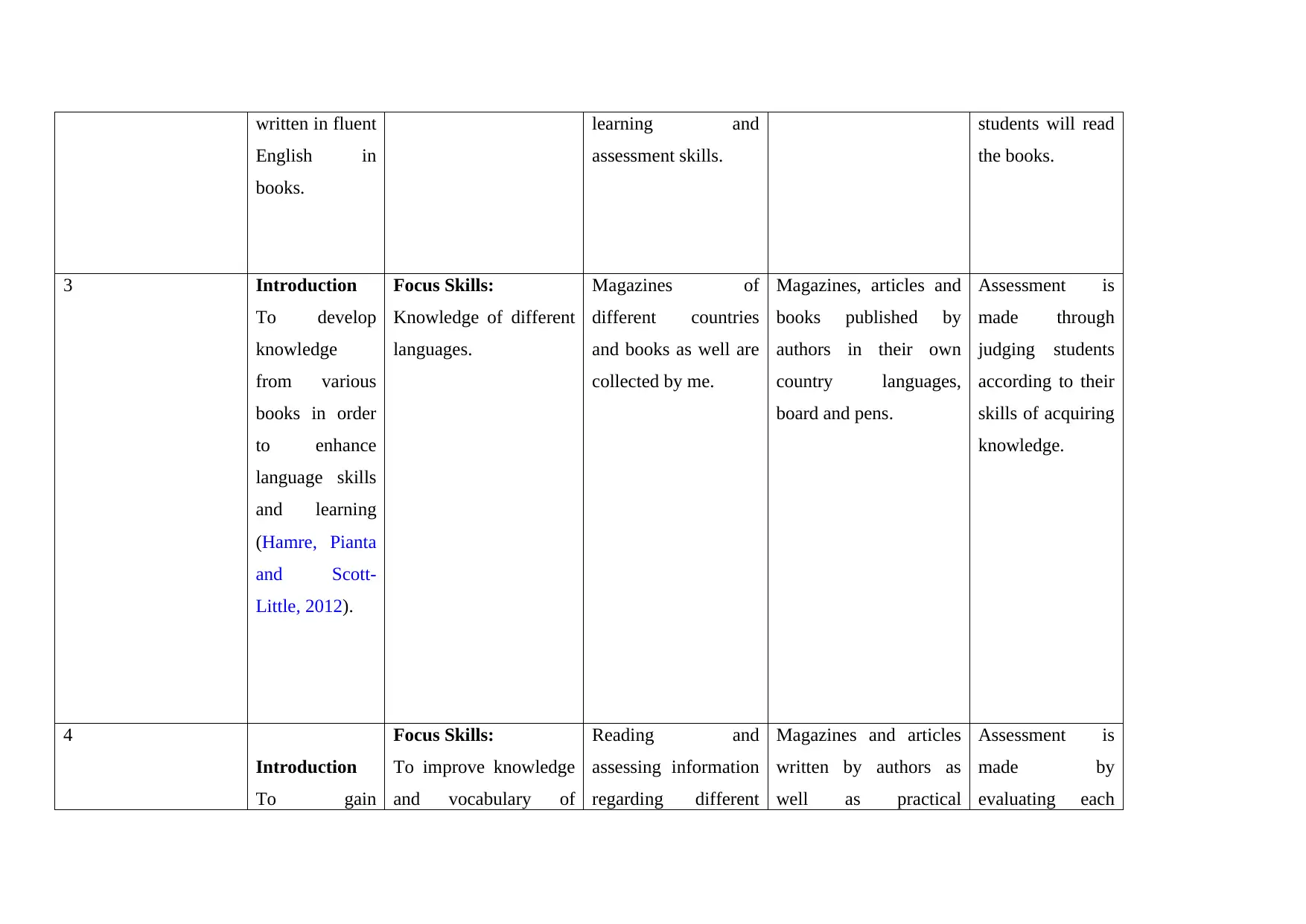
written in fluent
English in
books.
learning and
assessment skills.
students will read
the books.
3 Introduction
To develop
knowledge
from various
books in order
to enhance
language skills
and learning
(Hamre, Pianta
and Scott-
Little, 2012).
Focus Skills:
Knowledge of different
languages.
Magazines of
different countries
and books as well are
collected by me.
Magazines, articles and
books published by
authors in their own
country languages,
board and pens.
Assessment is
made through
judging students
according to their
skills of acquiring
knowledge.
4
Introduction
To gain
Focus Skills:
To improve knowledge
and vocabulary of
Reading and
assessing information
regarding different
Magazines and articles
written by authors as
well as practical
Assessment is
made by
evaluating each
English in
books.
learning and
assessment skills.
students will read
the books.
3 Introduction
To develop
knowledge
from various
books in order
to enhance
language skills
and learning
(Hamre, Pianta
and Scott-
Little, 2012).
Focus Skills:
Knowledge of different
languages.
Magazines of
different countries
and books as well are
collected by me.
Magazines, articles and
books published by
authors in their own
country languages,
board and pens.
Assessment is
made through
judging students
according to their
skills of acquiring
knowledge.
4
Introduction
To gain
Focus Skills:
To improve knowledge
and vocabulary of
Reading and
assessing information
regarding different
Magazines and articles
written by authors as
well as practical
Assessment is
made by
evaluating each
⊘ This is a preview!⊘
Do you want full access?
Subscribe today to unlock all pages.

Trusted by 1+ million students worldwide
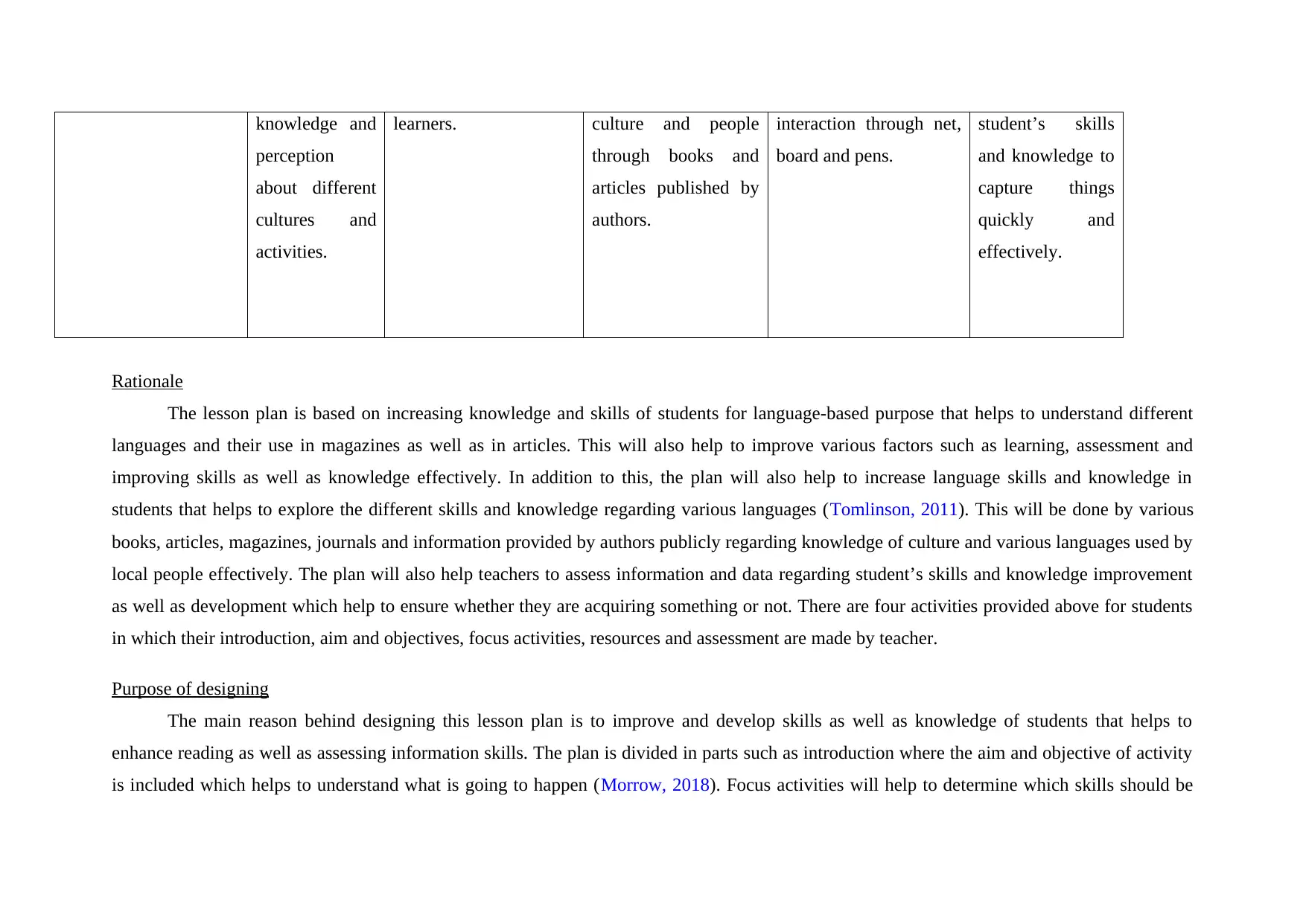
knowledge and
perception
about different
cultures and
activities.
learners. culture and people
through books and
articles published by
authors.
interaction through net,
board and pens.
student’s skills
and knowledge to
capture things
quickly and
effectively.
Rationale
The lesson plan is based on increasing knowledge and skills of students for language-based purpose that helps to understand different
languages and their use in magazines as well as in articles. This will also help to improve various factors such as learning, assessment and
improving skills as well as knowledge effectively. In addition to this, the plan will also help to increase language skills and knowledge in
students that helps to explore the different skills and knowledge regarding various languages (Tomlinson, 2011). This will be done by various
books, articles, magazines, journals and information provided by authors publicly regarding knowledge of culture and various languages used by
local people effectively. The plan will also help teachers to assess information and data regarding student’s skills and knowledge improvement
as well as development which help to ensure whether they are acquiring something or not. There are four activities provided above for students
in which their introduction, aim and objectives, focus activities, resources and assessment are made by teacher.
Purpose of designing
The main reason behind designing this lesson plan is to improve and develop skills as well as knowledge of students that helps to
enhance reading as well as assessing information skills. The plan is divided in parts such as introduction where the aim and objective of activity
is included which helps to understand what is going to happen (Morrow, 2018). Focus activities will help to determine which skills should be
perception
about different
cultures and
activities.
learners. culture and people
through books and
articles published by
authors.
interaction through net,
board and pens.
student’s skills
and knowledge to
capture things
quickly and
effectively.
Rationale
The lesson plan is based on increasing knowledge and skills of students for language-based purpose that helps to understand different
languages and their use in magazines as well as in articles. This will also help to improve various factors such as learning, assessment and
improving skills as well as knowledge effectively. In addition to this, the plan will also help to increase language skills and knowledge in
students that helps to explore the different skills and knowledge regarding various languages (Tomlinson, 2011). This will be done by various
books, articles, magazines, journals and information provided by authors publicly regarding knowledge of culture and various languages used by
local people effectively. The plan will also help teachers to assess information and data regarding student’s skills and knowledge improvement
as well as development which help to ensure whether they are acquiring something or not. There are four activities provided above for students
in which their introduction, aim and objectives, focus activities, resources and assessment are made by teacher.
Purpose of designing
The main reason behind designing this lesson plan is to improve and develop skills as well as knowledge of students that helps to
enhance reading as well as assessing information skills. The plan is divided in parts such as introduction where the aim and objective of activity
is included which helps to understand what is going to happen (Morrow, 2018). Focus activities will help to determine which skills should be
Paraphrase This Document
Need a fresh take? Get an instant paraphrase of this document with our AI Paraphraser
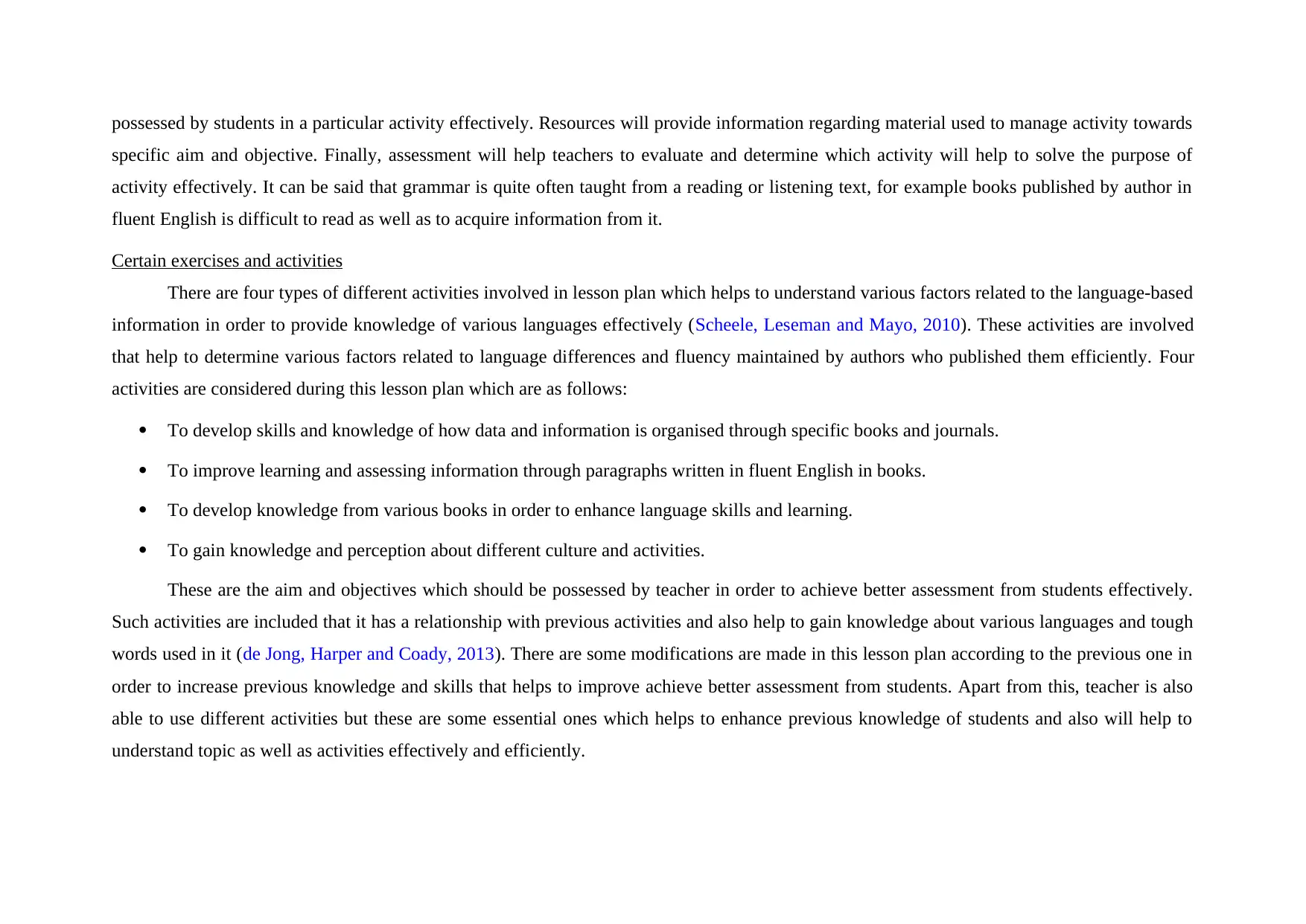
possessed by students in a particular activity effectively. Resources will provide information regarding material used to manage activity towards
specific aim and objective. Finally, assessment will help teachers to evaluate and determine which activity will help to solve the purpose of
activity effectively. It can be said that grammar is quite often taught from a reading or listening text, for example books published by author in
fluent English is difficult to read as well as to acquire information from it.
Certain exercises and activities
There are four types of different activities involved in lesson plan which helps to understand various factors related to the language-based
information in order to provide knowledge of various languages effectively (Scheele, Leseman and Mayo, 2010). These activities are involved
that help to determine various factors related to language differences and fluency maintained by authors who published them efficiently. Four
activities are considered during this lesson plan which are as follows:
To develop skills and knowledge of how data and information is organised through specific books and journals.
To improve learning and assessing information through paragraphs written in fluent English in books.
To develop knowledge from various books in order to enhance language skills and learning.
To gain knowledge and perception about different culture and activities.
These are the aim and objectives which should be possessed by teacher in order to achieve better assessment from students effectively.
Such activities are included that it has a relationship with previous activities and also help to gain knowledge about various languages and tough
words used in it (de Jong, Harper and Coady, 2013). There are some modifications are made in this lesson plan according to the previous one in
order to increase previous knowledge and skills that helps to improve achieve better assessment from students. Apart from this, teacher is also
able to use different activities but these are some essential ones which helps to enhance previous knowledge of students and also will help to
understand topic as well as activities effectively and efficiently.
specific aim and objective. Finally, assessment will help teachers to evaluate and determine which activity will help to solve the purpose of
activity effectively. It can be said that grammar is quite often taught from a reading or listening text, for example books published by author in
fluent English is difficult to read as well as to acquire information from it.
Certain exercises and activities
There are four types of different activities involved in lesson plan which helps to understand various factors related to the language-based
information in order to provide knowledge of various languages effectively (Scheele, Leseman and Mayo, 2010). These activities are involved
that help to determine various factors related to language differences and fluency maintained by authors who published them efficiently. Four
activities are considered during this lesson plan which are as follows:
To develop skills and knowledge of how data and information is organised through specific books and journals.
To improve learning and assessing information through paragraphs written in fluent English in books.
To develop knowledge from various books in order to enhance language skills and learning.
To gain knowledge and perception about different culture and activities.
These are the aim and objectives which should be possessed by teacher in order to achieve better assessment from students effectively.
Such activities are included that it has a relationship with previous activities and also help to gain knowledge about various languages and tough
words used in it (de Jong, Harper and Coady, 2013). There are some modifications are made in this lesson plan according to the previous one in
order to increase previous knowledge and skills that helps to improve achieve better assessment from students. Apart from this, teacher is also
able to use different activities but these are some essential ones which helps to enhance previous knowledge of students and also will help to
understand topic as well as activities effectively and efficiently.
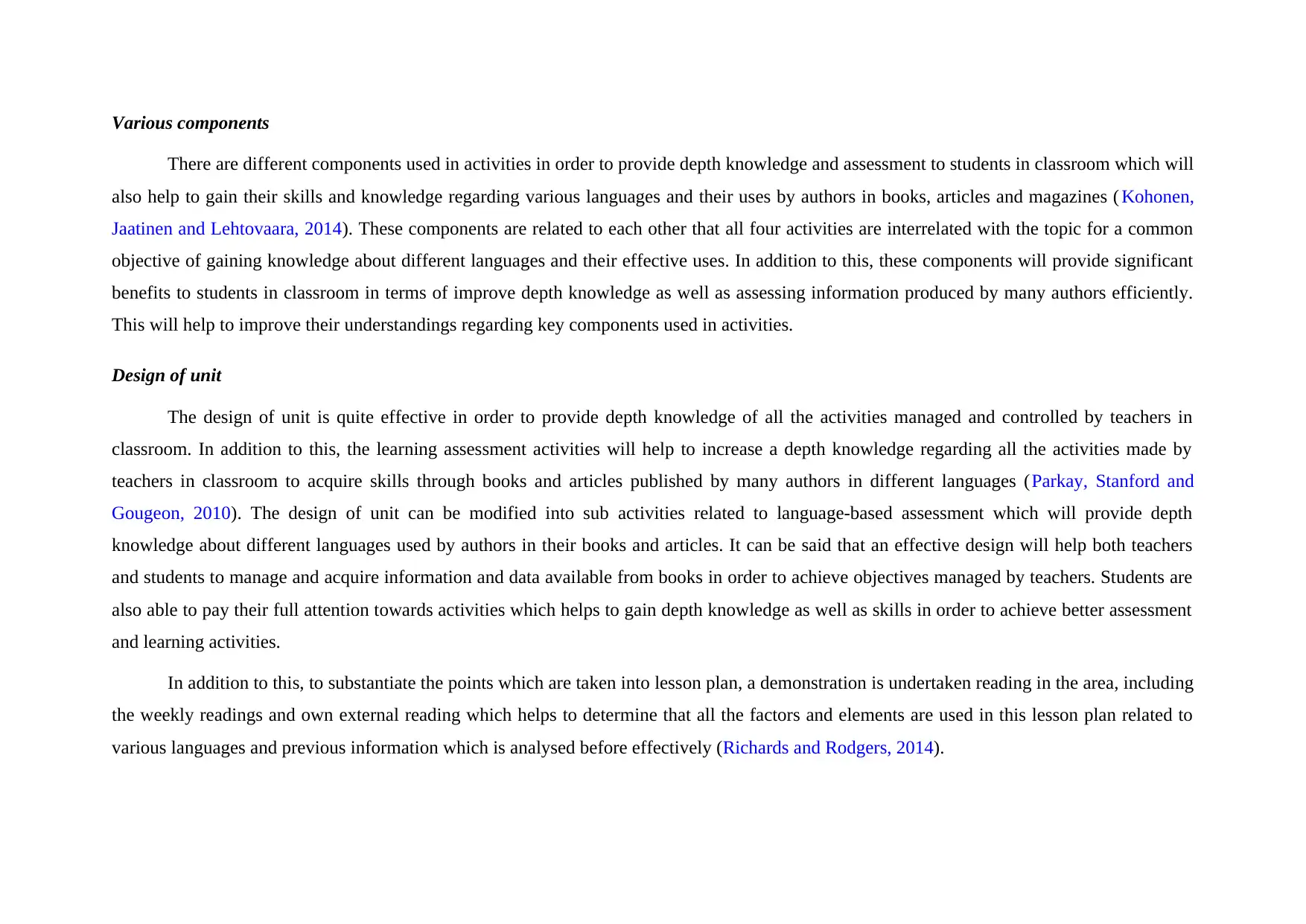
Various components
There are different components used in activities in order to provide depth knowledge and assessment to students in classroom which will
also help to gain their skills and knowledge regarding various languages and their uses by authors in books, articles and magazines ( Kohonen,
Jaatinen and Lehtovaara, 2014). These components are related to each other that all four activities are interrelated with the topic for a common
objective of gaining knowledge about different languages and their effective uses. In addition to this, these components will provide significant
benefits to students in classroom in terms of improve depth knowledge as well as assessing information produced by many authors efficiently.
This will help to improve their understandings regarding key components used in activities.
Design of unit
The design of unit is quite effective in order to provide depth knowledge of all the activities managed and controlled by teachers in
classroom. In addition to this, the learning assessment activities will help to increase a depth knowledge regarding all the activities made by
teachers in classroom to acquire skills through books and articles published by many authors in different languages (Parkay, Stanford and
Gougeon, 2010). The design of unit can be modified into sub activities related to language-based assessment which will provide depth
knowledge about different languages used by authors in their books and articles. It can be said that an effective design will help both teachers
and students to manage and acquire information and data available from books in order to achieve objectives managed by teachers. Students are
also able to pay their full attention towards activities which helps to gain depth knowledge as well as skills in order to achieve better assessment
and learning activities.
In addition to this, to substantiate the points which are taken into lesson plan, a demonstration is undertaken reading in the area, including
the weekly readings and own external reading which helps to determine that all the factors and elements are used in this lesson plan related to
various languages and previous information which is analysed before effectively (Richards and Rodgers, 2014).
There are different components used in activities in order to provide depth knowledge and assessment to students in classroom which will
also help to gain their skills and knowledge regarding various languages and their uses by authors in books, articles and magazines ( Kohonen,
Jaatinen and Lehtovaara, 2014). These components are related to each other that all four activities are interrelated with the topic for a common
objective of gaining knowledge about different languages and their effective uses. In addition to this, these components will provide significant
benefits to students in classroom in terms of improve depth knowledge as well as assessing information produced by many authors efficiently.
This will help to improve their understandings regarding key components used in activities.
Design of unit
The design of unit is quite effective in order to provide depth knowledge of all the activities managed and controlled by teachers in
classroom. In addition to this, the learning assessment activities will help to increase a depth knowledge regarding all the activities made by
teachers in classroom to acquire skills through books and articles published by many authors in different languages (Parkay, Stanford and
Gougeon, 2010). The design of unit can be modified into sub activities related to language-based assessment which will provide depth
knowledge about different languages used by authors in their books and articles. It can be said that an effective design will help both teachers
and students to manage and acquire information and data available from books in order to achieve objectives managed by teachers. Students are
also able to pay their full attention towards activities which helps to gain depth knowledge as well as skills in order to achieve better assessment
and learning activities.
In addition to this, to substantiate the points which are taken into lesson plan, a demonstration is undertaken reading in the area, including
the weekly readings and own external reading which helps to determine that all the factors and elements are used in this lesson plan related to
various languages and previous information which is analysed before effectively (Richards and Rodgers, 2014).
⊘ This is a preview!⊘
Do you want full access?
Subscribe today to unlock all pages.

Trusted by 1+ million students worldwide
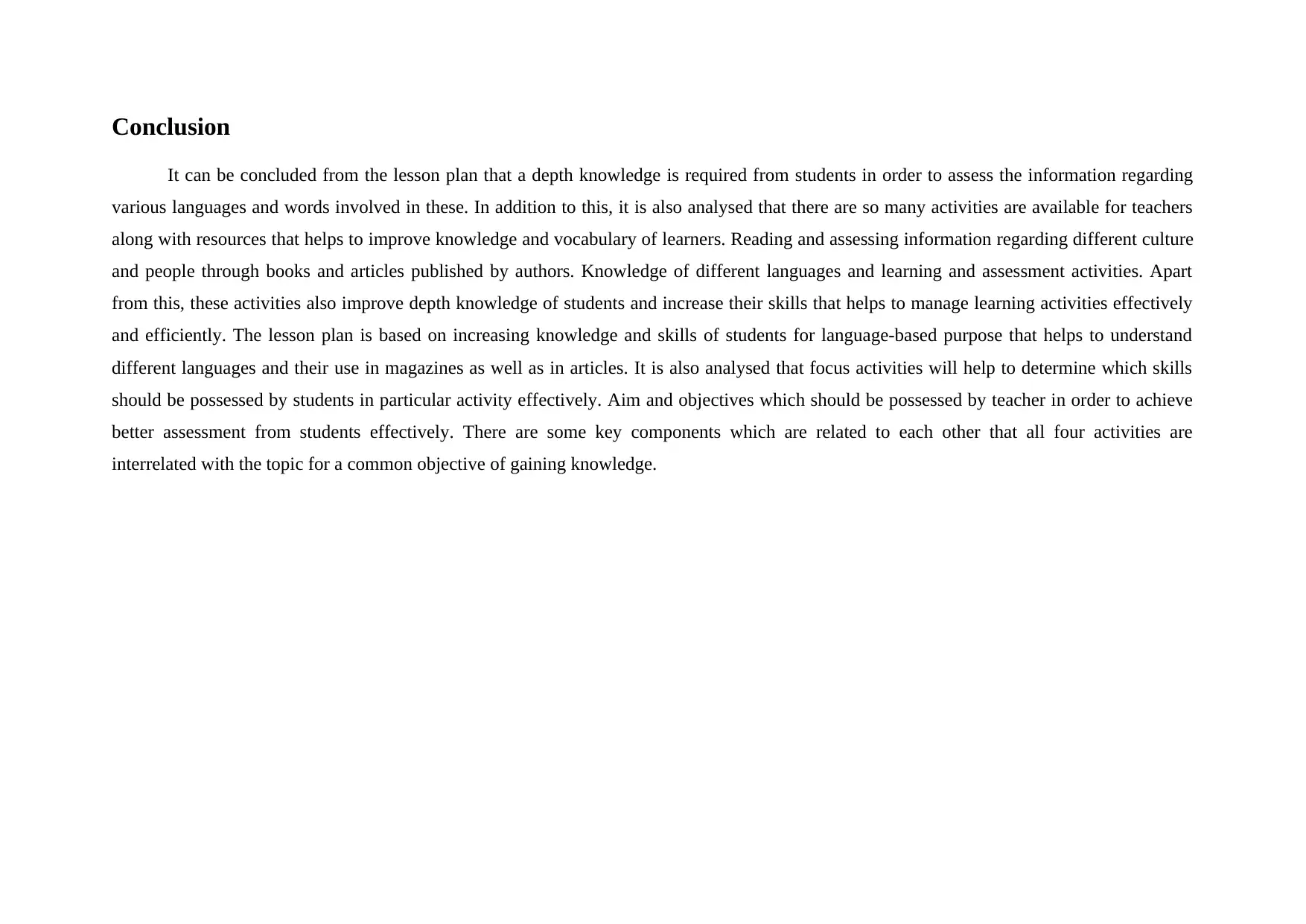
Conclusion
It can be concluded from the lesson plan that a depth knowledge is required from students in order to assess the information regarding
various languages and words involved in these. In addition to this, it is also analysed that there are so many activities are available for teachers
along with resources that helps to improve knowledge and vocabulary of learners. Reading and assessing information regarding different culture
and people through books and articles published by authors. Knowledge of different languages and learning and assessment activities. Apart
from this, these activities also improve depth knowledge of students and increase their skills that helps to manage learning activities effectively
and efficiently. The lesson plan is based on increasing knowledge and skills of students for language-based purpose that helps to understand
different languages and their use in magazines as well as in articles. It is also analysed that focus activities will help to determine which skills
should be possessed by students in particular activity effectively. Aim and objectives which should be possessed by teacher in order to achieve
better assessment from students effectively. There are some key components which are related to each other that all four activities are
interrelated with the topic for a common objective of gaining knowledge.
It can be concluded from the lesson plan that a depth knowledge is required from students in order to assess the information regarding
various languages and words involved in these. In addition to this, it is also analysed that there are so many activities are available for teachers
along with resources that helps to improve knowledge and vocabulary of learners. Reading and assessing information regarding different culture
and people through books and articles published by authors. Knowledge of different languages and learning and assessment activities. Apart
from this, these activities also improve depth knowledge of students and increase their skills that helps to manage learning activities effectively
and efficiently. The lesson plan is based on increasing knowledge and skills of students for language-based purpose that helps to understand
different languages and their use in magazines as well as in articles. It is also analysed that focus activities will help to determine which skills
should be possessed by students in particular activity effectively. Aim and objectives which should be possessed by teacher in order to achieve
better assessment from students effectively. There are some key components which are related to each other that all four activities are
interrelated with the topic for a common objective of gaining knowledge.
Paraphrase This Document
Need a fresh take? Get an instant paraphrase of this document with our AI Paraphraser
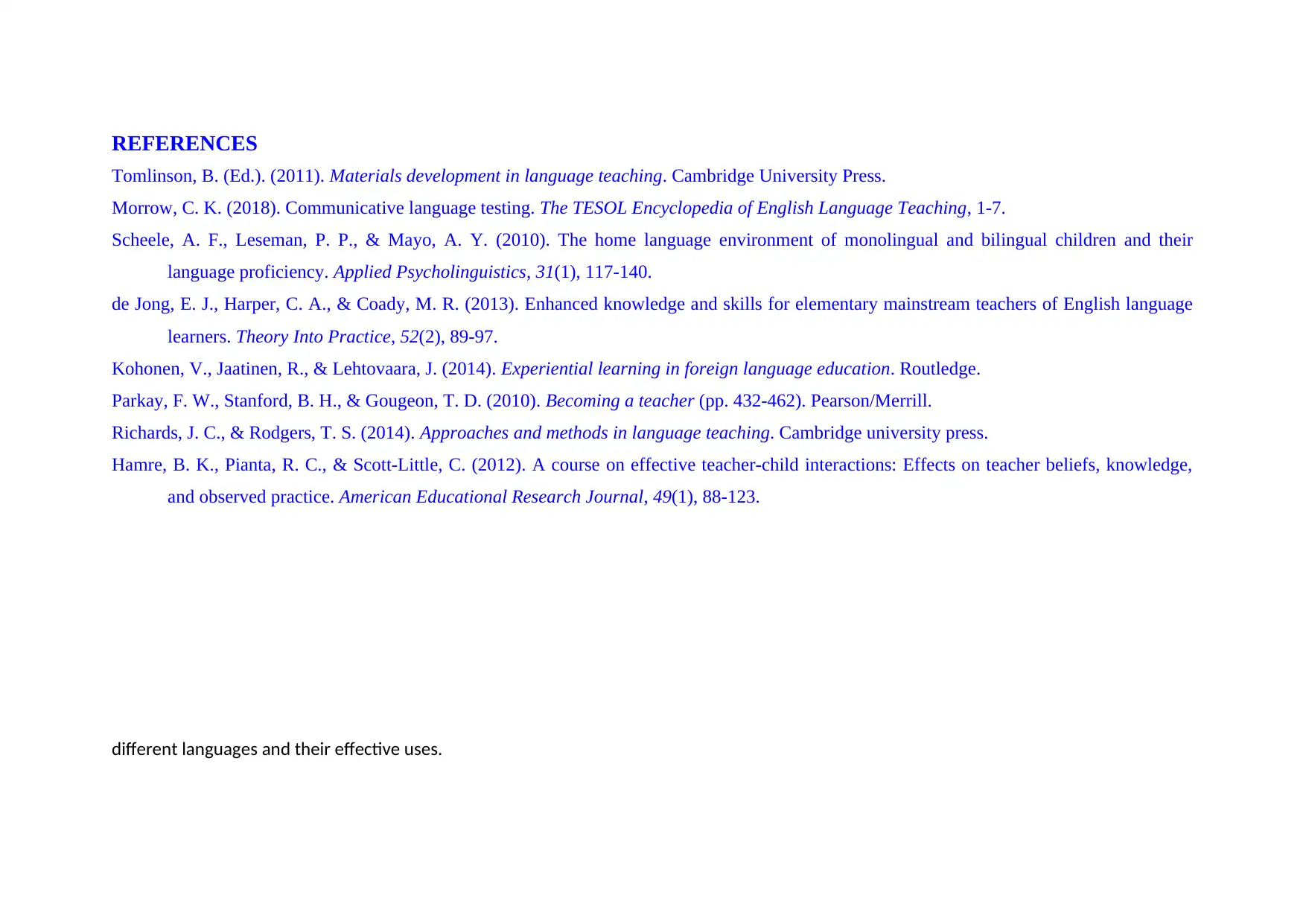
REFERENCES
Tomlinson, B. (Ed.). (2011). Materials development in language teaching. Cambridge University Press.
Morrow, C. K. (2018). Communicative language testing. The TESOL Encyclopedia of English Language Teaching, 1-7.
Scheele, A. F., Leseman, P. P., & Mayo, A. Y. (2010). The home language environment of monolingual and bilingual children and their
language proficiency. Applied Psycholinguistics, 31(1), 117-140.
de Jong, E. J., Harper, C. A., & Coady, M. R. (2013). Enhanced knowledge and skills for elementary mainstream teachers of English language
learners. Theory Into Practice, 52(2), 89-97.
Kohonen, V., Jaatinen, R., & Lehtovaara, J. (2014). Experiential learning in foreign language education. Routledge.
Parkay, F. W., Stanford, B. H., & Gougeon, T. D. (2010). Becoming a teacher (pp. 432-462). Pearson/Merrill.
Richards, J. C., & Rodgers, T. S. (2014). Approaches and methods in language teaching. Cambridge university press.
Hamre, B. K., Pianta, R. C., & Scott-Little, C. (2012). A course on effective teacher-child interactions: Effects on teacher beliefs, knowledge,
and observed practice. American Educational Research Journal, 49(1), 88-123.
different languages and their effective uses.
Tomlinson, B. (Ed.). (2011). Materials development in language teaching. Cambridge University Press.
Morrow, C. K. (2018). Communicative language testing. The TESOL Encyclopedia of English Language Teaching, 1-7.
Scheele, A. F., Leseman, P. P., & Mayo, A. Y. (2010). The home language environment of monolingual and bilingual children and their
language proficiency. Applied Psycholinguistics, 31(1), 117-140.
de Jong, E. J., Harper, C. A., & Coady, M. R. (2013). Enhanced knowledge and skills for elementary mainstream teachers of English language
learners. Theory Into Practice, 52(2), 89-97.
Kohonen, V., Jaatinen, R., & Lehtovaara, J. (2014). Experiential learning in foreign language education. Routledge.
Parkay, F. W., Stanford, B. H., & Gougeon, T. D. (2010). Becoming a teacher (pp. 432-462). Pearson/Merrill.
Richards, J. C., & Rodgers, T. S. (2014). Approaches and methods in language teaching. Cambridge university press.
Hamre, B. K., Pianta, R. C., & Scott-Little, C. (2012). A course on effective teacher-child interactions: Effects on teacher beliefs, knowledge,
and observed practice. American Educational Research Journal, 49(1), 88-123.
different languages and their effective uses.
1 out of 8
Related Documents
Your All-in-One AI-Powered Toolkit for Academic Success.
+13062052269
info@desklib.com
Available 24*7 on WhatsApp / Email
![[object Object]](/_next/static/media/star-bottom.7253800d.svg)
Unlock your academic potential
Copyright © 2020–2025 A2Z Services. All Rights Reserved. Developed and managed by ZUCOL.




